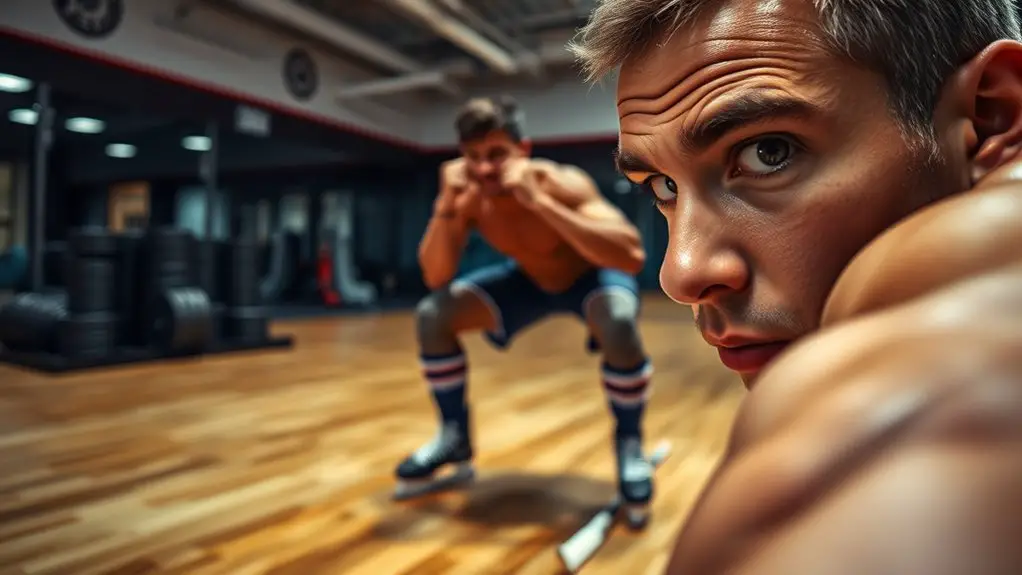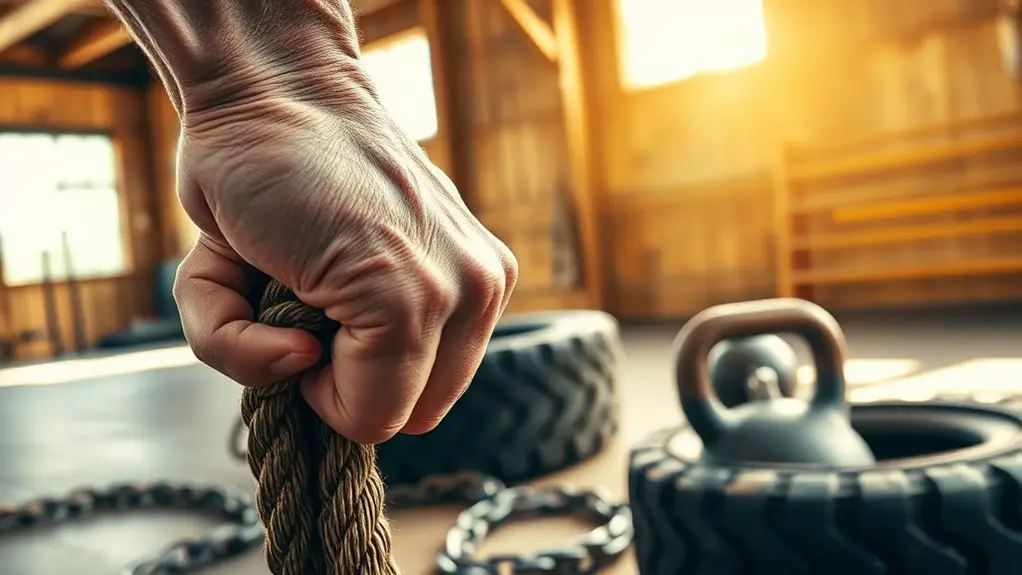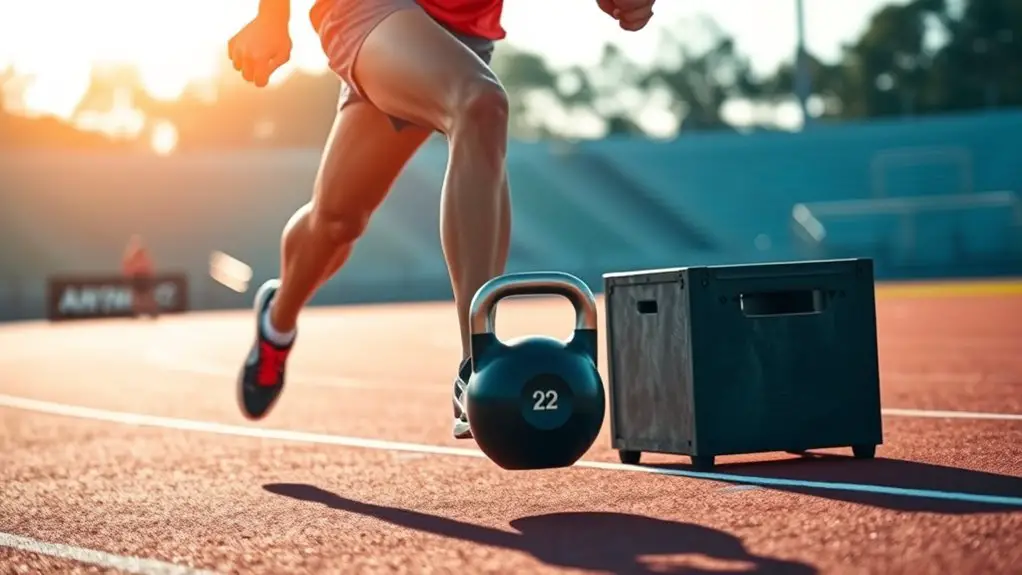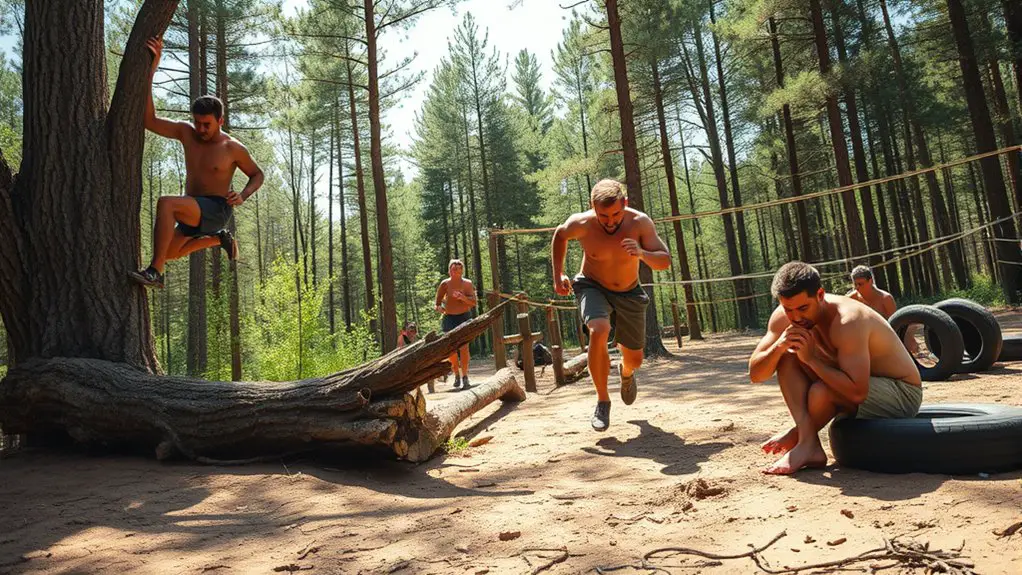For hockey players, strength training is essential for improving on-ice performance. Focus on core exercises like planks and medicine ball throws to enhance balance. Build leg strength with squats and deadlifts for better skating power. Don't overlook upper body strength; push-ups and bench presses will help with shot power. Incorporate plyometric exercises like box jumps for explosiveness. These combined efforts will elevate your game, and there's plenty more to explore on maximizing your training effectiveness.
Importance of Strength Training in Hockey
While many might focus solely on skill and strategy, strength training is essential for hockey players looking to elevate their game. Building strength isn't just about lifting weights; it's about empowering your body to perform at its peak. When you strengthen your muscles, you enhance your on-ice performance, boosting your speed and agility. You'll find that stronger legs help you skate faster and maintain balance during those tight turns.
Moreover, strength training reduces the risk of injuries, allowing you to play freely without the fear of getting sidelined. It equips you with the endurance needed to push through those intense games, giving you an edge over your opponents. By committing to a solid strength training routine, you're not just building muscle; you're building confidence, resilience, and the ability to express your full potential on the ice. Embrace the freedom that comes with strength, and watch your game transform. Additionally, improving overall stability and control through strength training can significantly enhance your performance on the ice.
Core Strength Exercises
When it comes to hockey, a strong core is essential for balance and power on the ice. Plank variations and medicine ball throws are two effective exercises that can help you build that core strength. Incorporating these movements into your routine can enhance your performance, as core strength acts as the foundation of athletic performance.
Plank Variations
Plank variations are fundamental for building core strength, which is essential for hockey players looking to enhance stability and power on the ice. Incorporating these exercises into your routine can help you maintain balance during intense maneuvers. Here are three effective plank variations to try:
- Side Plank: This targets your obliques and improves lateral stability, important for quick direction changes.
- Plank with Arm Reach: Extend one arm forward while maintaining your plank position. It challenges your balance and engages your core even more.
- Plank Jacks: From a plank position, jump your feet out and in. This adds a cardio element while strengthening your core.
Integrate these into your training, and you'll feel the difference on the ice!
Medicine Ball Throws
Building on core strength is vital for hockey players, and medicine ball throws are a fantastic way to enhance that power. These explosive movements engage your core while mimicking the dynamic actions you perform on the ice. Start with a partner or a wall, holding the medicine ball at your chest. As you pivot your hips, release the ball with force, focusing on your rotational strength. This exercise not only builds power but also improves your coordination and balance, essential for skating and shooting. Incorporate various throws—overhead, side, or chest—to target different muscle groups. By consistently practicing medicine ball throws, you'll develop the core stability and strength needed to elevate your game and unleash your full potential on the rink.
Leg Strength Exercises
Leg strength is essential for hockey players, as it directly impacts skating power, speed, and stability on the ice. To elevate your game, incorporate these leg strength exercises into your routine:
- Squats: Whether using body weight or adding weights, squats build overall leg strength and improve your explosive movements.
- Lunges: Forward, reverse, or lateral lunges enhance balance and agility, vital for quick direction changes on the ice.
- Deadlifts: This compound movement targets your hamstrings and glutes, helping you generate more power in your strides. Additionally, strong posterior chain development through deadlifts is vital for sports performance.
Upper Body Strength Exercises
While leg strength is essential for hockey players, upper body strength shouldn't be overlooked, as it plays a significant role in shooting, passing, and maintaining puck control. Focusing on your upper body can enhance your overall game. Here are some effective exercises to take into account:
| Exercise | Benefits |
|---|---|
| Push-Ups | Builds chest and triceps strength |
| Pull-Ups | Strengthens back and biceps |
| Bench Press | Increases upper body power |
| Dumbbell Rows | Improves back stability |
| Shoulder Press | Enhances shoulder strength |
Incorporating these exercises into your routine can help you dominate on the ice. Remember, a strong upper body not only aids in offensive plays but also helps you fend off defenders. Additionally, focusing on injury prevention strategies is vital for maintaining peak performance throughout the season. Train hard, and you'll notice the difference in your performance, giving you the freedom to play your game with confidence.
Plyometric Training for Explosiveness
Plyometric training is essential for boosting your explosiveness on the ice. By incorporating key exercises like box jumps and squat jumps, you can enhance your power and agility. Let's explore how these workouts can benefit your performance as a hockey player. Additionally, plyometric exercises focus on the stretch-shortening cycle of muscles, allowing for maximum potential and improved athletic performance.
Key Plyometric Exercises
To maximize your explosiveness on the ice, incorporating key plyometric exercises into your training regimen is essential. These dynamic movements can enhance your power and agility, giving you the edge during gameplay. Here are three must-try plyometric exercises:
- Box Jumps: Jump onto a sturdy box or platform to boost your vertical leap and leg strength.
- Depth Jumps: Step off a box and explode upward upon landing, improving your reactive strength and speed.
- Broad Jumps: Leap forward as far as you can, focusing on powerful leg drive and balance.
Adding these exercises into your routine will help you develop the explosiveness needed to dominate on the ice. Let your training be your ticket to freedom and performance!
Benefits for Hockey Players
Incorporating plyometric training into your routine offers numerous benefits that can greatly enhance your performance on the ice. First off, these explosive movements improve your power, allowing you to accelerate quickly and deliver harder shots. You'll notice a boost in your overall speed, making it easier to outpace opponents. Plyometrics also increase your agility, helping you navigate the ice with sharper turns and quicker reactions. Plus, they enhance your balance and coordination, which are essential for maintaining control during intense plays. You'll build strength without sacrificing flexibility, ensuring your body responds dynamically during games. Embracing this training will not only elevate your game but also give you the freedom to play at your best.
Resistance Training Techniques
Resistance training techniques are essential for hockey players looking to enhance their strength and overall performance on the ice. By incorporating these methods into your routine, you'll not only build muscle but also improve your explosive power and endurance. Here are three effective techniques to take into account:
- Olympic Lifts: Movements like the clean and jerk or snatch develop overall strength and coordination, vital for quick skater movements.
- Compound Exercises: Squats, deadlifts, and bench presses target multiple muscle groups, promoting functional strength that translates directly to on-ice performance.
- Plyometrics: Incorporating explosive exercises such as box jumps or medicine ball slams helps improve your agility and speed, allowing for more dynamic play. Additionally, focusing on proper technique during these lifts enhances lifting efficiency and reduces injury risk.
Focus on these techniques, and you'll feel the difference in your game. Embrace the freedom of strength training, and watch your skills soar!
Flexibility and Mobility Work
While strength is essential for hockey players, flexibility and mobility work shouldn't be overlooked. These components are important for your overall performance on the ice, allowing you to move freely and efficiently. Improved flexibility helps prevent injuries by enhancing your range of motion, which is crucial for executing powerful shots and quick turns.
Incorporating dynamic stretches and mobility drills into your routine can enhance your skating stride and agility. Think about incorporating exercises like hip openers, dynamic lunges, and shoulder dislocates to keep your joints limber. Additionally, focusing on enhanced flexibility can lead to improved muscle efficiency and reduced energy expenditure during games.
Don't forget static stretching post-practice or game; it aids recovery and maintains flexibility.
Sample Strength Training Routine for Hockey Players
A well-structured strength training routine is essential for hockey players looking to enhance their performance on the ice. To build your strength, consider incorporating these key elements into your training:
- Squats: Focus on bodyweight or weighted squats to build leg strength, vital for skating power.
- Deadlifts: This exercise strengthens your posterior chain, improving balance and explosiveness during games.
- Bench Press: A strong upper body helps with stick handling and body checks, so don't skip this one!
Aim to perform these exercises 2-3 times a week, allowing enough recovery time in between. Start with lighter weights to master your form, then gradually increase the load. Remember, consistency is key! Incorporating plyometric exercises into your routine can further boost your explosiveness on the ice. Your hard work in the gym will translate to greater endurance and strength on the ice, giving you the freedom to play your game without holding back. Keep pushing your limits, and watch your performance soar!
Frequently Asked Questions
How Often Should Hockey Players Train for Strength?
You should train for strength about two to three times a week, ensuring you balance intensity with recovery. It's essential to listen to your body and adjust your routine for ideal performance and injury prevention.
What Equipment Is Best for Strength Training at Home?
For home strength training, you'll want versatile equipment like dumbbells, resistance bands, and a stability ball. These allow you to perform a wide range of exercises, keeping your routine effective and engaging without needing a gym.
Can Strength Training Improve My Skating Speed?
Studies show that strength training can boost skating speed by up to 20%. By incorporating targeted exercises into your routine, you'll enhance your power and explosiveness, allowing you to glide effortlessly across the ice.
How Do I Prevent Injuries During Strength Training?
To prevent injuries during strength training, you should always warm up, use proper form, and listen to your body. Gradually increase weights and take rest days—your body needs time to recover and stay strong.
Should I Focus on Strength or Endurance for Hockey?
Imagine a tree; strength is its trunk, endurance the branches. For hockey, you need both to thrive. Focus on building strength while incorporating endurance training; they'll give you the freedom to dominate the ice.




